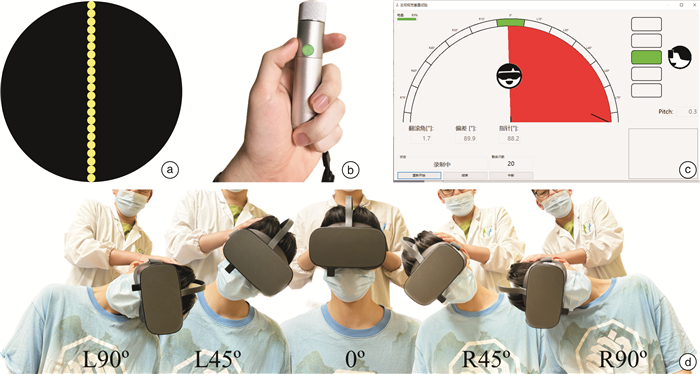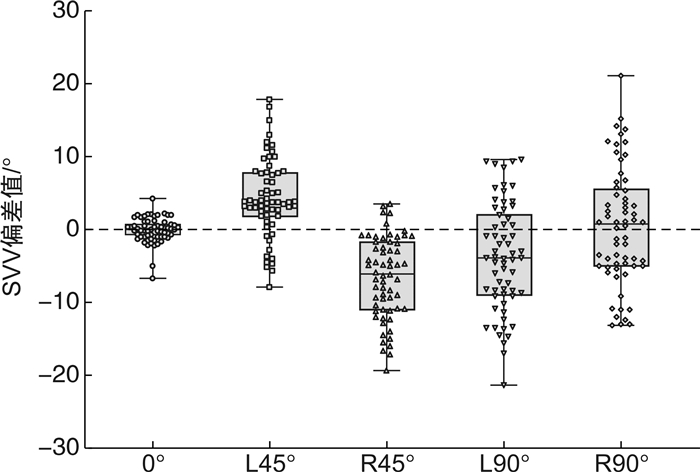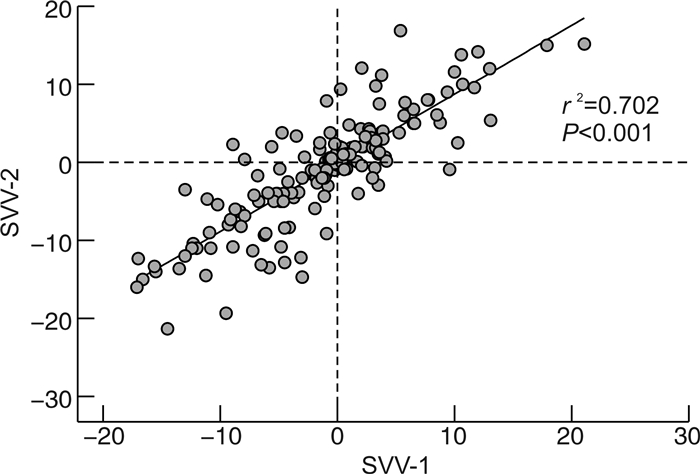Test-retest reliability of subjective visual vertical from different head-tilt angles in young healthy adults
-
摘要: 目的 建立不同头位偏斜角度下的主观视觉垂直线(subjective visual vertical,SVV)正常值数据,并分析其复测信度,为SVV的临床应用提供参考。方法 选取31名健康青年人,佩戴虚拟现实眼镜,分别测试在直立头位0°、左头位偏斜45°(L45°)、右头位偏斜45°(R45°)、左头位偏斜90°(L90°)、右头位偏斜90°(R90°)5个不同角度下的SVV数据,并于2周后进行复测。结果 ① 0°、L45°、R45°、L90°、R90° 5个不同头位偏斜角度下的SVV平均值分别为:-0.07±1.71、4.30±5.39、-6.51±5.58、-3.76±7.42、0.40±8.02,95%CI分别为:(-3.42,3.28)、(-6.26,14.86)、(-17.45,4.43)、(-18.30,10.78)、(-15.32,16.12);②L45°、R45°、L90°、R90°4个不同头位偏斜角度下的SVV偏差绝对值分别为:5.62±3.96、6.90±5.07、6.82±4.70、6.48±4.68;95%CI分别为:(0,12.11)、(0,15.21)、(0,14.53)、(0,14.16);双侧45°偏差绝对值的不对称性比为10%;双侧90°偏差绝对值的不对称性比为3%;③0°、L45°、R45°、L90°、R90° SVV的组内相关系数分别为0.757、0.673、0.674、0.815、0.856。结论 SVV具有良好的复测信度,临床测试稳定性高,本研究建立的不同偏斜角度下SVV正常值数据可辅助临床对前庭系统疾病进行精细化诊断和功能评估。Abstract: Objective To establish the normal values of subjective visual vertical (SVV) in different head deflection angles and analyze its test and retest reliability, in order to provide a reference for the clinical application of SVV in the evaluation of vestibular disorders.Methods Thirty-one healthy young people were selected to wear VR glasses, and the SVV data were tested in five different head-tilt, namely, 0° in the upright head position, 45°in the left head position, 45° in the right head position, 90° in the left head position, and 90° in the right head position, and were re-tested 2 weeks later.Results ① The mean values of SVV at 5 different head-tilt angles of 0°, left 45°, right 45°, left 90°, and right 90° were -0.07±1.71, 4.30±5.39, -6.51±5.58, -3.76±7.42, and 0.40±8.02, respectively, The 95% confidence limits of SVV at 0°, left 45°, right 45°, left 90°, right 90°, and right 90° were (-3.42, 3.28), (-6.26, 14.86), (-17.45, 4.43), (-18.30, 10.78), and(-15.32, 16.12), respectively; ②The absolute values of SVV at 4 different head-tilt angles of left 45°, right 45°, left 90°, and right 90° were 5.62±3.96, 6.90±5.07, 6.82±4.70 and 6.48±4.68, respectively. The 95% confidence limits of SVV at left 45°, right 45°, left 90°, right 90°, and right 90° were(0, 12.11), (0, 15.21), (0, 14.53)and(0, 14.16), respectively. The asymmetry ratio is 10% for the absolute value of the 45 ° deviation and 3% for the absolute value of the 90° deviation; ③Intra-class correlation coefficients(ICC) for 0°, left 45°, right 45°, left 90°, right 90°were 0.757, 0.673, 0.674, 0.815, and 0.856, respectively.Conclusion SVV has good retest reliability and high stability, and the SVV normal value data of different head deviation angles established in the present study can be used as a reference for the diagnosis and evaluation of vestibular disorders.
-

-
表 1 不同头位偏斜角度下SVV正常值及95%CI
头位 Mean SD 95%CI 0 -0.07 1.71 (-3.42,3.28) L45° 4.30 5.39 (-6.26,14.86) R45° -6.51 5.58 (-17.45,4.43) L90° -3.76 7.42 (-18.30,10.78) R90° 0.40 8.02 (-15.32,16.12) 表 2 SVV双侧不对称性比较
头位 绝对值均值 绝对值标准差 绝对值95%CI 不对称比/% t P L45° 5.62 3.96 (0,12.11) 10.0 -1.563 0.121 R45° 6.90 5.07 (0,15.21) L90° 6.82 4.70 (0,14.53) 3.0 0.414 0.680 R90° 6.48 4.68 (0,14.16) 表 3 2组不同头位偏斜角度下的SVV复测信度
头位 r ICC 95%CI P 0° 0.779 0.757 (0.540,0.877) < 0.001 L45° 0.726 0.673 (0.380,0.836) < 0.001 R45° 0.669 0.674 (0.423,0.829) < 0.001 L90° 0.826 0.815 (0.649,0.907) < 0.001 R90° 0.854 0.856 (0.722,0.928) < 0.001 -
[1] Böhmer A, Mast F. Assessing otolith function by the subjective visual vertical[J]. Ann N Y Acad Sci, 1999, 871: 221-231. doi: 10.1111/j.1749-6632.1999.tb09187.x
[2] Taylor RL, Welgampola MS. Otolith Function Testing[J]. Adv Otorhinolaryngol, 2019, 82: 47-55.
[3] Kumagami H, Sainoo Y, Fujiyama D, et al. Subjective visual vertical in acute attacks of Ménière's disease[J]. Otol Neurotol, 2009, 30(2): 206-209. doi: 10.1097/MAO.0b013e3181925010
[4] Sakagami M, Wada Y, Shiozaki T, et al. Results of subjective visual vertical tests in patients with vertigo/dizziness[J]. Auris Nasus Larynx, 2022, 49(3): 342-346. doi: 10.1016/j.anl.2021.08.010
[5] 李越, 张勤, 马孝宝, 等. 不同旋转方式对主观视觉垂直线检测结果的影响[J]. 临床耳鼻咽喉头颈外科杂志, 2022, 36(9): 665-669. https://lceh.whuhzzs.com/article/doi/10.13201/j.issn.2096-7993.2022.09.003
[6] 成颖, 陈耔辰, 李桔林, 等. 正常人视频头脉冲试验结果分析[J]. 听力学及言语疾病杂志, 2019, 27(6): 591-595. https://www.cnki.com.cn/Article/CJFDTOTAL-TLXJ201906003.htm
[7] 贾宏博, 刘波, 杜一, 等. 前庭功能检查专家共识(二)(2019)[J]. 中华耳科学杂志, 2019, 17(2): 144-149. https://www.cnki.com.cn/Article/CJFDTOTAL-ZHER201902003.htm
[8] Cicchetti D. Guidelines, Criteria, and Rules of Thumb for Evaluating Normed and Standardized Assessment Instrument in Psychology[J]. Psychological Assessment, 1994, 6: 284-90. doi: 10.1037/1040-3590.6.4.284
[9] Kachar B, Parakkal M, Fex J. Structural basis for mechanical transduction in the frog vestibular sensory apparatus: I. The otolithic membrane[J]. Hear Res, 1990, 45(3): 179-190. doi: 10.1016/0378-5955(90)90119-A
[10] Wong AM. New understanding on the contribution of the central otolithic system to eye movement and skew deviation[J]. Eye(Lond), 2015, 29(2): 153-156.
[11] Sharpe JA, Kumar S, Sundaram AN. Ocular torsion and vertical misalignment[J]. Curr Opin Neurol, 2011, 24(1): 18-24. doi: 10.1097/WCO.0b013e328341e2b2
[12] Obrero-Gaitan E, Molina F, Montilla-Ibanez MD, et al. Misperception of Visual Vertical in Peripheral Vestibular Disorders. A Systematic Review With Meta-Analysis[J]. Laryngoscope, 2021, 131(5): 1110-1121. doi: 10.1002/lary.29124
[13] Brodsky MC, Donahue SP, Vaphiades M, et al. Skew deviation revisited[J]. Surv Ophthalmol, 2006, 51(2): 105-128. doi: 10.1016/j.survophthal.2005.12.008
[14] Michelson PL, McCaslin DL, Jacobson GP, et al. Assessment of Subjective Visual Vertical(SVV)Using the "Bucket Test" and the Virtual SVV System[J]. Am J Audiol, 2018, 27(3): 249-259. doi: 10.1044/2018_AJA-17-0019
[15] Balestrucci P, Maffei V, Lacquaniti F, et al. The Effects of Visual Parabolic Motion on the Subjective Vertical and on Interception[J]. Neuroscience, 2021, 453: 124-137. doi: 10.1016/j.neuroscience.2020.09.052
[16] Anastasopoulos D, Haslwanter T, Bronstein A, et al. Dissociation between the perception of body verticality and the visual vertical in acute peripheral vestibular disorder in humans[J]. Neurosci Lett, 1997, 233(2-3): 151-153. doi: 10.1016/S0304-3940(97)00639-3
[17] Curthoys IS, Dai MJ, Halmagyi GM. Human ocular torsional position before and after unilateral vestibular neurectomy[J]. Exp Brain Res, 1991, 85(1): 218-225. http://eurekamag.com/pdf/007/007410470.pdf
[18] Wade SW, Curthoys IS. The effect of ocular torsional position on perception of the roll-tilt of visual stimuli[J]. Vision Res, 1997, 37(8): 1071-1078. doi: 10.1016/S0042-6989(96)00252-0
[19] Dieterich M, Brandt T. Perception of Verticality and Vestibular Disorders of Balance and Falls[J]. Front Neurol, 2019, 10: 172. doi: 10.3389/fneur.2019.00172
[20] Ferreira MM, Ganança MM, Caovilla HH. Subjective visual vertical after treatment of benign paroxysmal positional vertigo[J]. Braz J Otorhinolaryngol, 2017, 83(6): 659-664. doi: 10.1016/j.bjorl.2016.08.014
[21] Bjasch D, Bockisch CJ, Straumann D, et al. Differential effects of visual feedback on subjective visual vertical accuracy and precision[J]. PLoS One, 2012, 7(11): e49311. doi: 10.1371/journal.pone.0049311
[22] Clarke AH, Schönfeld U, Helling K. Unilateral examination of utricle and saccule function[J]. J Vestib Res, 2003, 13(4-6): 215-225. doi: 10.3233/VES-2003-134-606
[23] Zhao C, Yang Q, Song J. Dynamic changes of otolith organ function before and after repositioning in patients with benign paroxysmal positional vertigo detected by virtual reality auxiliary technology: A cohort study[J]. Front Neurol, 2022, 13: 1007992. doi: 10.3389/fneur.2022.1007992
[24] 成颖, 张玉忠, 陈飞云, 等. 虚拟现实辅助下的主观视觉垂直线与主观视觉水平线检测[J]. 中华耳科学杂志, 2019, 17(6): 895-899. https://www.cnki.com.cn/Article/CJFDTOTAL-ZHER201906018.htm
[25] Wang CH, Winnick AA, Ko YH, et al. Test-retest reliability of subjective visual vertical measurements with lateral head tilt in virtual reality goggles[J]. Tzu Chi Med J, 2021, 33(3): 294-300. doi: 10.4103/tcmj.tcmj_207_20
-





 下载:
下载:

